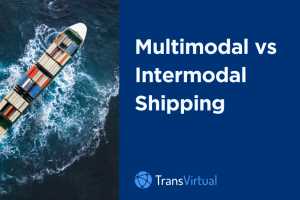Table of Contents
When moving goods, freight forwarders likely come across the terms multimodal and intermodal transportation.
Generally, both methods are a type of freight transportation (via trucks, rail transport, air freight, sea, etc.). They typically involve different modes of transport throughout the process but differ in terms of contract or agreements.
Today, you’ll get an in-depth look at intermodal vs multimodal transportation. There are benefits when using multimodal freight and distinct advantages for companies that go for intermodal freight.
By the end of the article, you’ll be able to make the right and most cost effective choice for your business.
What Is Multimodal Transport?
In multimodal transport, only one contract covers the entire journey of the cargo. Simply put, one carrier takes full responsibility for door-to-door delivery, even if they use other modes along the journey. These modes can include:
Truck
Rail
Barge
Ship
Any combination of these
A key document in this process is the Combined Transport Bill of Lading (or Multimodal bill of lading). It outlines the kind, amount, and final destination of goods that are being transported from one location to another. It also serves as a receipt as soon as the goods reach its final destination.
From origin to destination, the contracted carrier issues only one Bill of Lading because they’re responsible for moving the shipment through each leg of the journey.
Let’s look at an example. If a business wants to send cargo from Sydney, Australia, to London in the UK, the shipment needs to move through two or more modes.
First, the carrier will pack the cargo in Sydney and move it by truck to the shipping port. This is most likely the Port of Botany. Then, it goes to a cargo ship, and the freight will move to the Port of London.
The carrier unloads the cargo from the discharging vessel onto trucks. The shipment travels by truck to the consignee and its final destination in London. On the other hand, if the final destination is elsewhere in the UK, the cargo may need to travel by different transport modes, such as railway or truck.
Regardless of what modes the cargo uses, you maintain one contract throughout the process.
Some shipping companies, acting as multimodal transport operators, have all modes of transport available to them. This makes it really simple to work with them to send cargo as they coordinate the entire journey under a single contract.
Those shipping with an agent may also use this shipping method. The shipper holds the single contract while the agent does all the negotiations behind the scenes. The agent also takes care of coordinating loading, unloading, and delays.
Benefits of Multimodal Shipping
Multimodal transportation has different benefits, lets look at a few of them:
Less Overhead Costs
The biggest advantage of this method is reduced costs. As you know, you only work with a single multimodal transport operator for every aspect of the shipping process.
There’s less handling and shipping costs and you often get a package of services under your contract. Everything from the transportation process, customs clearance and even cargo tracking are handled by one transport carrier.
Tracking is More Efficient
Shipment tracking in multimodal transportation is efficient and easy. Operators can provide access to remote parts of the world through their network. The shipper will face fewer logistics coordination expenses too.
Reduced Delivery Time
Multimodal transportation reduces your overall delivery time by choosing the fastest mode for each step of the journey. For example, a truck might be the most efficient when delivering in remote or less accessible locations (and shorter distances) while planes are good when you want to carry cargo across long distances.
What Is Intermodal Transport?

Intermodal shipping also moves cargo from origin to destination using several modes of transport. A separate transport carrier handles the various modes of transportation, and each leg has an independent contract.
Intermodal containers are the standardized units used for this purpose, facilitating the seamless transfer of cargo between ships, trains, and trucks without the need to unload and reload the cargo itself.
An intermodal container revolutionizes the way goods are transported globally, offering a secure and efficient method for shipping cargo across various modes of transport.
Using the example earlier, a new contract is in place each time the cargo switches modes. The truck from the warehouse to the Port of Botany is one contract. The vessel from Sydney to London is another contract and so on.
Benefits of Intermodal Shipping
There are also several advantages of intermodal transport, in fact, it happens to be a key strategy for reducing total shipping cost. Lets learn more about this below:
Flexibility and Savings
A key benefit of intermodal shipping is having the freedom to negotiate terms separately with each company. This could lead to better shipping rates and fewer expenses.
But unfortunately, it also means more overhead for shippers. This is because the shipper needs to handle several contracts and coordinate delays between companies as opposed to working with a single carrier.
Yet, the intermodal shipping method gives shippers flexibility and specialised handling of loading and unloading goods at different ports.
Reduced Carbon Footprint
They can also reduce their carbon footprint by working with environmentally-friendly shipping companies. As consumers become more vocal about the environmental impact of global shipping, this benefit is becoming more critical.
Enhanced Safety and Control
The intermodal method also gives shippers increased security of their products during transport. Plus, shippers can better control capacity and transit schedules.
Intermodal and Multimodal Transport: Which Is Better?
Both intermodal and multimodal transport move cargo from origin to destination, utilizing more than one method of transportation. They each combine the most efficient transportation modes to:
Optimise lead times
Reduce inventory costs
Keep the level of freight costs down
Increase environmental sustainability
Lessen carbon footprint
In multimodal transport, a single contract is signed with the same transport carrier responsible for the entire journey, simplifying logistics and reducing overhead.
Conversely, intermodal transport involves separate transport carriers for different legs of the journey, requiring multiple contracts and more logistics coordination. This distinction highlights the differences in how transportation is organized in intermodal vs multimodal methods, affecting flexibility, rates, environmental impact, ease of management, speed of deliveries, and responsibility in case of issues.
Both methods also require a transportation management system (TMS) to ensure tracking visibility and allow businesses to perform routing scenarios across various transport modes, providing the best shipping costs and transit times.
That all said, the key difference lies with the contract. So, which one should shippers use?
For now, many businesses still prefer the multimodal method since using the same contract is easier to manage. However, leveraging intermodal transport can lead to better cost savings and flexibility.
Find Your Shipping Partner
Whether you choose to ship using the intermodal vs. multimodal method, it’s most important to find a reliable partner. Working with a transparent, trustworthy, and timely company is essential.
To learn more about solutions and answers to your biggest transport-related questions, make sure you follow us at TransVirtual and check out more articles from our blog.



